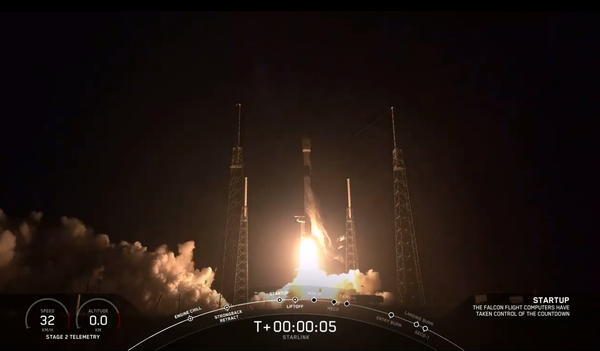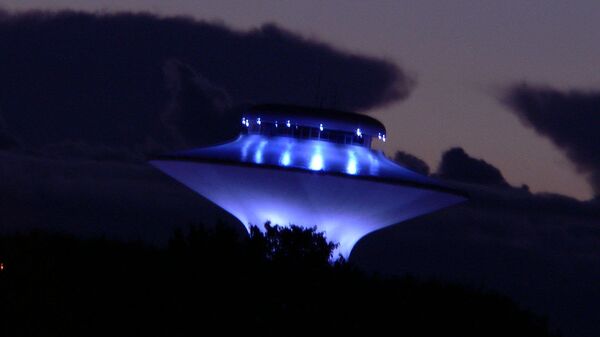A spooky succession of perfectly aligned lights spotted in the skies above northern Italy on 23 December generated a frenzy of responses on the internet as people shared their observations in the belief that the sighting was of an extraterrestrial nature.
Those who saw the satellites took to social media to guess what was beaming across the night sky.
WTF is this trail of 25+ eerily silent 'lights' flying in a constant stream high in the sky over Northern Italy?!?! Santa please say it's you? #SantaTracker #sleighsighting #UFOWTF #ufosighting pic.twitter.com/LKzrMEXJBb
— Hattie Scott (@hihattie) December 24, 2019
...We saw it in Varese, Italy... Can someone throw some... light on the matter??
— Giovanni Ghersi (@gioghersi) December 24, 2019
UFOs definitely pic.twitter.com/m0lWtgn1d8
— ▩▩▨▨uɐʎɹ▧▧▩▩ (@toaster55s) December 23, 2019
However, it has since been confirmed that the lights were part of Elon Musk’s second group of Starlink satellites launched into orbit last November as part of his huge internet project.
Experts from the Italian astronomical observatory explained:
"It is the Starlink satellites that Elon Musk launched. You can sleep peacefully.”
If you saw a row of UFO like lights in the sky in IL, IA, MI (like this but spaced out), that was SpaceX Starlink Satellites! You'll be able to see them in the next few days, too!
— Dr. Jen Golbeck 💗💜💙 (@jengolbeck) December 23, 2019
Check here for a map (and set the time back to see their track today) https://t.co/wtkU9xSFY9 pic.twitter.com/cZ4UUvj5Zc
Many netizens were disappointed with the mundane explanation for the creepy sighting:
Come on, at least let the conspiracy theorists run rampant for a few days before shutting them down 😉
— Andrea (@qtb_dk) December 23, 2019
Little one was hoping it was Santa coming early
— Aries Doberman (@AriesDoberman) December 25, 2019
I did see this.
— Angel Goulet 🧐 (@AngelGoulet) December 25, 2019
I thought the aliens were coming!!!
My sister and I saw these the evening of December 24, 2019 - we are in central Montana. Quite interesting.
— Linda Casper (@lindamcasper) December 26, 2019
I saw them too, but in harbor oregon😃cool sight!
— Debe (@Debe25257112) December 26, 2019
Netizens also shared their opinions of the ambitious Starlink project:
I like the concept of Starlink, but the impact on astronomy and astrophotographers is not ideal :(
— Kevin Boyd (@Beryllium9) December 23, 2019
Yes I have heard people in those professions claim that the whole Starlink project is interfering with their work. I've even heard it said that SpaceX is "ruining" the night sky for normal viewing.
— DontTreadOnMe71 (@OnMe71) December 26, 2019
Starlink is a satellite constellation being constructed by American company SpaceX to provide satellite Internet access.
Team is go for launch of 60 Starlink sats tomorrow—heaviest payload to date, first re-flight of a fairing, and first Falcon 9 to fly a fourth mission. Watching 1 sat that may not orbit raise; if not, 100% of its components will quickly burn up in Earth’s atmosphere pic.twitter.com/OrI8L0ntFK
— SpaceX (@SpaceX) November 11, 2019
In November SpaceX successfully launched 60 of its Starlink satellites into orbit. They were carried into space by a SpaceX Falcon 9 rocket, which took off at 14:56 UTC from a launchpad in Cape Canaveral, Florida.
The stated aim of SpaceX's Starlink project is to create a vast network of satellites to bring high-speed internet to remote and rural parts of the world.
Although the original plans for Starlink listed just under 12,000 satellites, Space News reported earlier in October that the company applied to the International Telecommunication Union (ITU) for permission to launch an additional 30,000.
As CEO Elon Musk is yet another step closer to his ambitious goal, an ever stronger chorus of experts have been expressing concerns that in the foreseeable future the sky above us will grow crowded with satellites.

Alex Parker, a planetary astronomer and the director of the Project for Exploration Science Pathfinder Research for Enhancing Solar System Observations (ESPRESSO), has been raising the alarm regarding the brightness of Starlink satellites in particular.
“I know people are excited about those images of the train of SpaceX Starlink satellites, but it gives me pause,” he wrote on Twitter in May.
I know people are excited about those images of the train of SpaceX Starlink satellites, but it gives me pause.
— Alex Parker (@Alex_Parker) May 25, 2019
They’re bright, and there are going to be a lot of them.
If SpaceX launches all 12,000, they will outnumber stars visible to the naked eye.
While striving to allay concerns, Elon Musk has been rather dismissive of the complaints.
“There are already 4900 satellites in orbit, which people notice [about] zero percent of the time... Starlink won’t be seen by anyone unless they're looking very carefully & will have [about] zero percent impact on advancements in astronomy,” he tweeted.
There are already 4900 satellites in orbit, which people notice ~0% of the time. Starlink won’t be seen by anyone unless looking very carefully & will have ~0% impact on advancements in astronomy. We need to move telelscopes to orbit anyway. Atmospheric attenuation is terrible. pic.twitter.com/OuWYfNmw0D
— Elon Musk (@elonmusk) May 27, 2019





